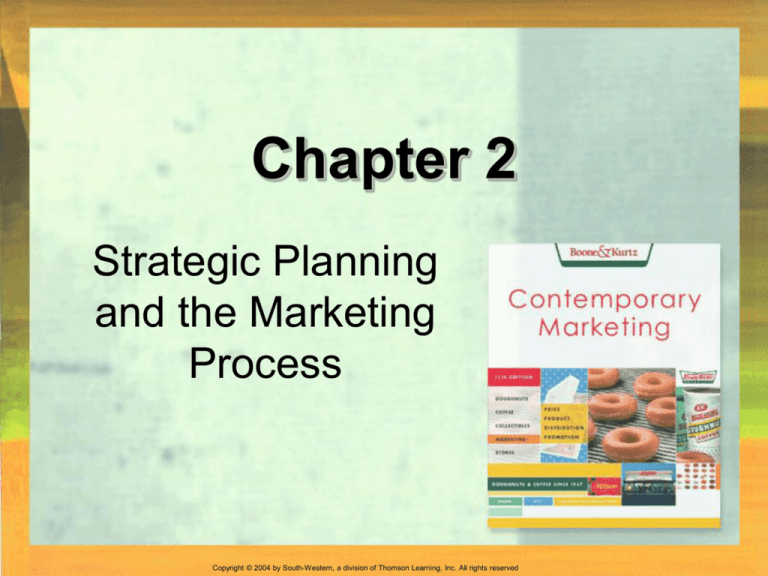
Chapter 2
Strategic Planning
and the Marketing
Process
Copyright © 2004 by South-Western, a division of Thomson Learning, Inc. All rights reserved.
What is Marketing Planning?
Planning: Anticipating future events and
conditions and determining the courses of
action necessary to achieve organizational
objectives
Marketing planning
2-2
Copyright © 2004 by South-Western, a division of Thomson Learning, Inc. All rights reserved.
Strategic Marketing Planning Levels
Mission/Goal Statement
Corporate Strategy
SBU Strategy
Marketing Strategy
Marketing Mix Elements
2-3
Copyright © 2004 by South-Western, a division of Thomson Learning, Inc. All rights reserved.
Kraft
Adding Products
to Increase
Market Share
2-4
Copyright © 2004 by South-Western, a division of Thomson Learning, Inc. All rights reserved.
GM Ads Strengthen Relationships With Women Car Buyers
2-5
Copyright © 2004 by South-Western, a division of Thomson Learning, Inc. All rights reserved.
Strategic Planning versus Tactical Planning
Strategic planning
Tactical planning
2-6
Copyright © 2004 by South-Western, a division of Thomson Learning, Inc. All rights reserved.
Planning at Different Organizational
Levels
Top managers
Middle level managers
Supervisors
2-7
Copyright © 2004 by South-Western, a division of Thomson Learning, Inc. All rights reserved.
Steps in the Marketing Planning
Process
2-8
Copyright © 2004 by South-Western, a division of Thomson Learning, Inc. All rights reserved.
Defining the Organization’s Mission
Mission: the essential purpose that
differentiates one company from another
2-9
Copyright © 2004 by South-Western, a division of Thomson Learning, Inc. All rights reserved.
Crest
Education
Programs:
Part of Procter &
Gamble’s Mission
to Improve the
Lives of
Consumers
2-10
Copyright © 2004 by South-Western, a division of Thomson Learning, Inc. All rights reserved.
Determining Organizational Objectives
An organization lays out its basic objectives,
or goals, in its mission statement
These objectives guide development of
supporting marketing objectives and plans
2-11
Copyright © 2004 by South-Western, a division of Thomson Learning, Inc. All rights reserved.
Assessing Organizational Resources and
Evaluating Environmental Risks and
Opportunities
SWOT analysis: The study of a firm’s internal
strengths and weaknesses and external
opportunities and threats
Strategic window: a limited period with an
optimal fit between the market and the firm
2-12
Copyright © 2004 by South-Western, a division of Thomson Learning, Inc. All rights reserved.
SWOT is an
acronym for
strengths,
weaknesses,
opportunities,
and threats
2-13
Copyright © 2004 by South-Western, a division of Thomson Learning, Inc. All rights reserved.
Taking Advantage of a
Strategic Window
Growth in Internet
Creates a Strategic
Window for
HydrogenMedia
2-14
Copyright © 2004 by South-Western, a division of Thomson Learning, Inc. All rights reserved.
Formulating a Marketing Strategy
Marketing strategy: a firm’s overall
program for selecting and satisfying a
target market
Requires a careful balance of the
marketing mix elements – each of which
represents a subset of the overall
marketing strategy
2-15
Copyright © 2004 by South-Western, a division of Thomson Learning, Inc. All rights reserved.
This advertisement shows the
Chrysler auto lineup including the
highly successful PT Cruiser.
Each product offering targets a
specific market segment.
2-16
Copyright © 2004 by South-Western, a division of Thomson Learning, Inc. All rights reserved.
Elements of a Marketing Strategy
Blending the four strategy elements of
marketing decision-making to satisfy chosen
target markets
Product
Price
Distribution
Promotion
2-17
Copyright © 2004 by South-Western, a division of Thomson Learning, Inc. All rights reserved.
Target Market
Group of
people
toward whom
the firm
decides to
direct its
marketing
efforts
2-18
Copyright © 2004 by South-Western, a division of Thomson Learning, Inc. All rights reserved.
Product Strategy
What goods or services to offer
Customer service
Package design
Brand names
Trademarks
Warranties
Product Life Cycle
Positioning
New-product development
2-19
Copyright © 2004 by South-Western, a division of Thomson Learning, Inc. All rights reserved.
Product Strategy: The cell
phone is now positioned to
compete directly with land-lines
as shown in this AT&T
advertisement.
2-20
Copyright © 2004 by South-Western, a division of Thomson Learning, Inc. All rights reserved.
Ad Stressing a New Package
Design
(Part of the Total Product)
2-21
Copyright © 2004 by South-Western, a division of Thomson Learning, Inc. All rights reserved.
Elements of the
Champion Product
Strategy
2-22
Copyright © 2004 by South-Western, a division of Thomson Learning, Inc. All rights reserved.
Distribution Strategy
Modes of transportation
Warehousing
Inventory control
Order processing
Marketing channels
2-23
Copyright © 2004 by South-Western, a division of Thomson Learning, Inc. All rights reserved.
This Ad illustrates the
Challenges of Finding
Distribution for your Product.
2-24
Copyright © 2004 by South-Western, a division of Thomson Learning, Inc. All rights reserved.
Promotional Strategy
Blending together the various elements of
promotion to communicate most effectively
with the target market
advertising
sales promotion
public relations
personal selling
2-25
Copyright © 2004 by South-Western, a division of Thomson Learning, Inc. All rights reserved.
This advertising campaign
communicates effectively with
its Target Market
2-26
Copyright © 2004 by South-Western, a division of Thomson Learning, Inc. All rights reserved.
Advertising As a Part
of the Pepto-Bismol
Promotional Strategy
2-27
Copyright © 2004 by South-Western, a division of Thomson Learning, Inc. All rights reserved.
Pricing Strategy
Deals with the methods of setting profitable
and justifiable prices
The Marketing Environment
Competitive
Social – Cultural
Technological
Economic
Political – Legal
2-28
Copyright © 2004 by South-Western, a division of Thomson Learning, Inc. All rights reserved.
The Competitive Environment, as
well as, changes in Technology,
has influenced the way these two
competitors differentiate their
product offerings.
2-29
Copyright © 2004 by South-Western, a division of Thomson Learning, Inc. All rights reserved.
TOYOTA
Ad Promotes a
Product Developed
for the Changing
Legal and SocialCultural
Environments
2-30
Copyright © 2004 by South-Western, a division of Thomson Learning, Inc. All rights reserved.
Tools for Marketing Planning
Strategic Business Units (SBUs) are key
business units within diversified firms
A division, product line, or single product
may define an SBU
Firms redesign their SBUs as market
conditions dictate
2-31
Copyright © 2004 by South-Western, a division of Thomson Learning, Inc. All rights reserved.
3M
Tape Products:
A 3M Strategic
Business Unit
2-32
Copyright © 2004 by South-Western, a division of Thomson Learning, Inc. All rights reserved.
Market Share/ Market Growth Matrix:
Classifies a firm’s products according to
industry growth rates and market shares
relative to competing products
Market Attractiveness/Business
Strength Matrix: Rates SBUs according
to the attractiveness of their markets and
their organizational strengths
2-33
Copyright © 2004 by South-Western, a division of Thomson Learning, Inc. All rights reserved.
Market Share/ Market Growth Matrix
2-34
Copyright © 2004 by South-Western, a division of Thomson Learning, Inc. All rights reserved.
Market Attractiveness/Business Strength Matrix
2-35
Copyright © 2004 by South-Western, a division of Thomson Learning, Inc. All rights reserved.
Spreadsheet analysis helps planners
anticipate marketing performance given
specified sets of circumstances
2-36
Copyright © 2004 by South-Western, a division of Thomson Learning, Inc. All rights reserved.








